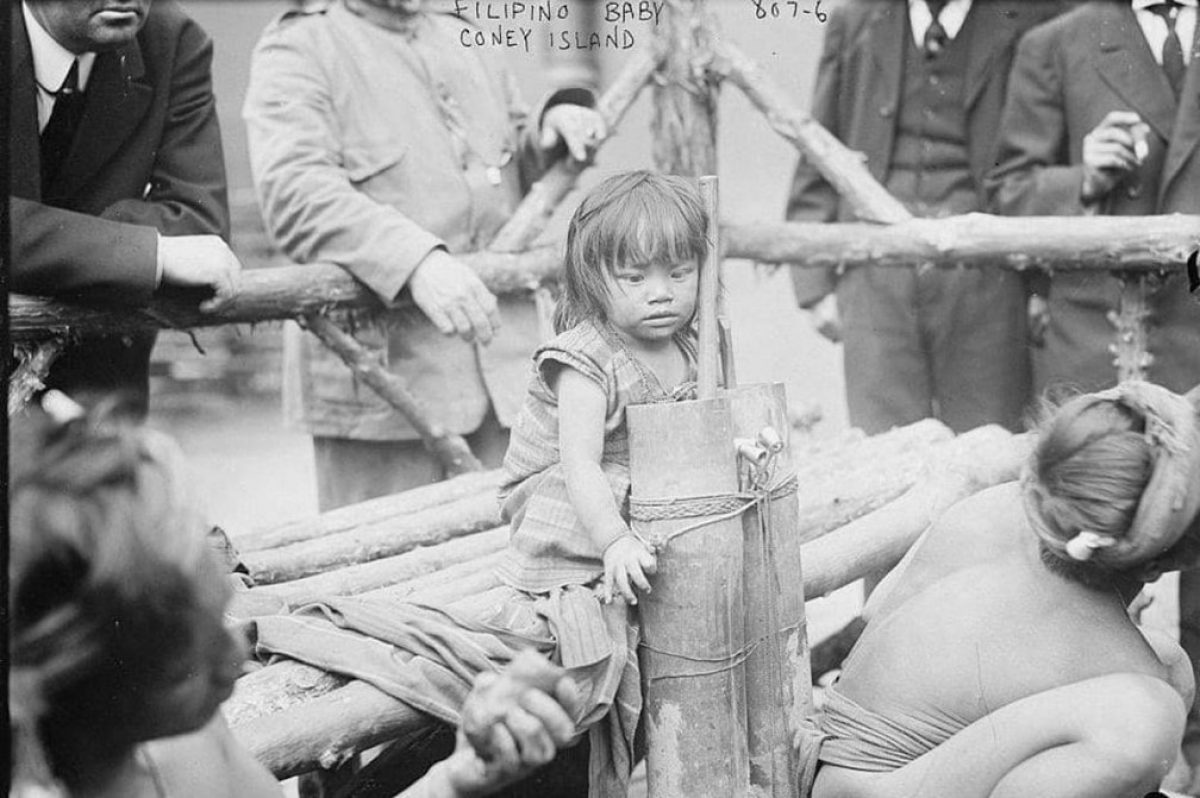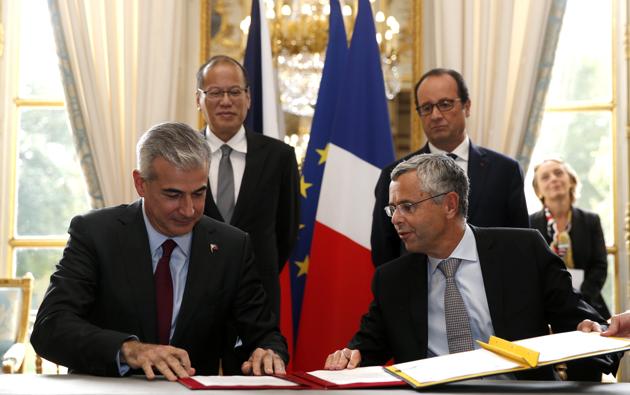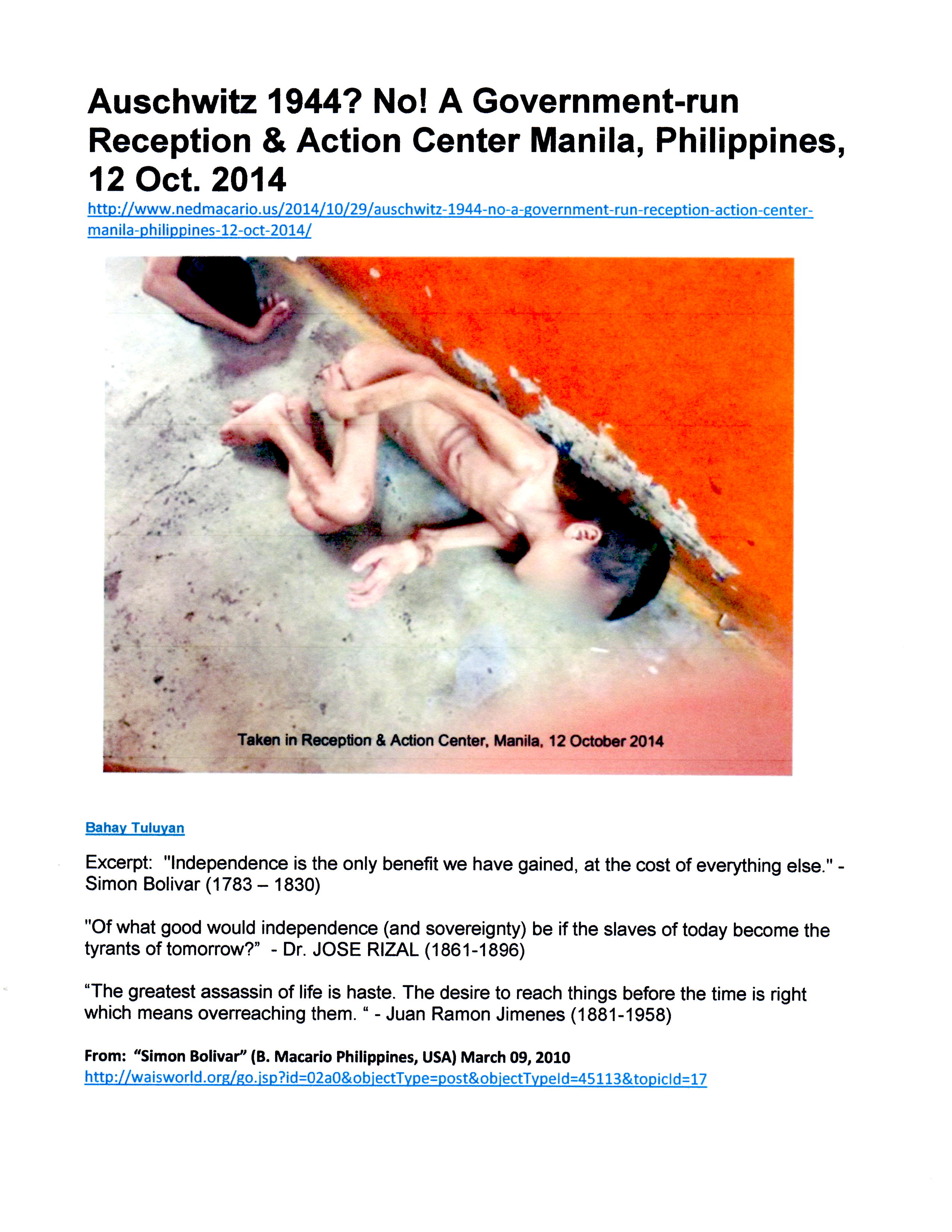
Make the Philippines an American Battle Monument

“The crime against our fellow creatures is not to hate them, but to be indifferent to them; that’s the essence of inhumanity.” – George Bernard Shaw in his play “The Devil’s Disciple” Act II (1901)
If there is such thing as hate crime, there should be the crime of indifference. –
Not everything is bad in the Philippines. Here’s a good one. An oligarch and ethnic Spaniard won a contract in France. The Alexander Graham Bell of the Philippines, Augusto or Fernando Zobel de Ayala and the A. G. Bell of France, Michel Combes signed a deal last 17 Sept. 2014. The photo of the skin and bones starving boy was taken on 12 Oct. 2014.
President Aquino Meets with His Majesty King Philippe of Belgium
17 September 2014 – Following his meeting with European Commission President Jose Manuel Barroso, President Benigno s. Aquino III had an audience with His Majesty King Philippe of Begium at the Royal Palace in Brussels on September 15.
In his meeting with King Philippe, the President conveyed the Philippines’ gratitude for Belgium’s assistance and the outpouring of support from the Belgian people in the aftermath of Typhoon Haiyan/Yolanda.
=================
Philippines’ Aquino seeking to reaffirm European support
Sept. 12, 2014
http://www.dw.de/philippines-aquino-seeking-to-reaffirm-european-support/a-17917736
Philippine President Benigno Aquino is embarking on his first European tour in a bid to boost economic ties and seek support for his country’s position in a maritime dispute with China, as analyst Ernest Bower tells DW.
Starting this Saturday, September 13, President Aquino of the Philippines is set to visit Spain, Belgium, France and Germany. One of the main goals of the ten-day trip is to lobby European governments for “moral support” for the Philippines’ legal dispute with China. A few months ago, Manila filed a formal submission with a special United Nations court, claiming that Beijing is breaching the Convention on the Law of the Sea by exploiting contested waters in the South China Sea.
=======================
The problem with Aquino III is the fact that like his mother he claims CHINA as his ancestral land! Mother and son are false flag presidents. His mother country is stealing from the country that took them in. Why not ask the help of the U.S.? Simple Aquino III is working for China!
June 11, 2014 – Aquino III’s False Flag Presidency
https://www.nedmacario.us/2014/06/11/aquino-iiis-false-flag-presidency/

The first step for President Hollande is to withdraw recognition of the so-called republic of the Philippines founded on lies, treason and dishonor. How would the French people feel if the GRANDSON of the Nazi collaborator PIERRE LAVAL and other grandchildren of Nazi collaborators are running France today? Benigno Aquino III and Mar Roxas II president of the Philippines and his right hand man are grandchildren of Japanese collaborators should have been executed or jailed and definitely be prohibited from participating in the government after WWII.
PHOTO: An oligarch and ethnic Spaniard won a contract in France. The Alexander Graham Bell of the Philippines, Augusto Zobel de Ayala and the A. G. Bell of France, Michel Combes signed a deal last 17 Sept. 2014.
From this time on France experienced a series of very bad luck starting with the Hebdo Massacre. Then Airbus A-320 of Germanwings Flight 9525 was deliberately crashed; another Airbus A-4000 Spanish Military plane crashed. The Airbus A-321 of Russian Airliner KGL-9268 was bombed on 31 Oct. 2015
And now the coordinated attack in Paris.
French President Francois Hollande (2nd row, R with a worried look) and Philippine President Benigno Aquino (2nd row,L), attended the signature ceremony of agreements.
====================
Mine is just an unsolicited suggestion. http://bfmbusiness.bfmtv.com/entreprise/pourquoi-alcatel-lucent-n-est-deja-plus-vraiment-francais-877353.html https://www.nedmacario.us/2014/11/07/augusto-zobel-de-ayala-signed-a-deal-with-alcatel-of-france/
Nov. 4, 2014
From: Girl’s (Marianneth Amper’s) suicide indicts Philippine anti-poverty programme
The World Bank, IMF and the U.N. will continue to aid and abet oppression and the undemocratic oligarchy in the Philippines. But we will all be judged by history. Facebook is the best thing that ever happened to civilization. We can no longer deny what is happening in the Philippines.
In Dec. 2007, the World Bank went ahead forgiving $16.5~ Billion debts of the poorest nations in Africa. (See Zero Sum Game of Global Finance Yet today there is still hunger and starvation in Africa. But it’s different now. It’s worse. We have Ebola virus that infected at least two health care workers in Dallas, TX.
Record Funding for World’s Poorest Countries as of 12-14-07
December 14, 2007
The record donor pledges for IDA15 represent a 42 percent increase from the previous replenishment. This is complemented by US$ 16.5 billion~ in internal financing from the World Bank Group and prior donor pledges for financing debt forgiveness.
===============================
“A child committing suicide because of hunger and poverty may be an isolated case, but Filipino families experiencing extreme hunger and poverty are definitely prevalent.“
“We have already seen and heard news of adults committing suicide in desperation borne out of poverty by jumping from billboards or hanging themselves,” Alphonse Rivera, head of the child rights organization, Salinlahi Alliance for Children’s Concerns, said in a statement sent to the Mindanao Examiner.
Oct. 20, 2014 – Seventieth Anniversary of MacArthur’s Leyte Landing in WWII
“If you think this is bad enough, add the recent revelations in Bayanko, like the event in Malolos Provincial Hospital where cats have infested the hospital and eating the carcass of a dead newly born baby. Then add how they feed the patients by getting the carers to pile in a line to collect the food and if you are at the back you do not get any food at all.
Do you know patients die in bulk in these hospitals and with no post mortems, as no one cares, no one knows what causes their death. It could be Ebola, TB, HIV, it can be anything and there is no safeguard because it is the hospital for the poor.
Now the statistic shows that 12.1 million families consider themselves poor –SWS Q3 poll and 40% of workers live in illegal settlements. So what are we doing my Kababayans. We celebrate EDSA 1 for what? To lower the standard of living to this level and just allow this irresponsible government to continue this way.”
